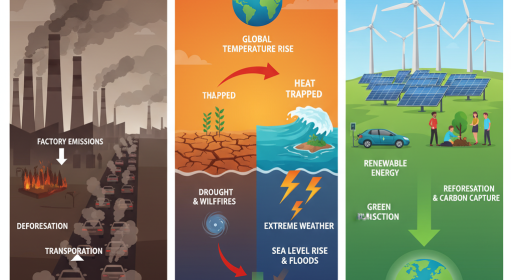Introduction
Mineral dust significantly influences the Earth system by affecting the radiation budget, cloud formation, and nutrient cycles. Understanding the accuracy of climate models in simulating dust aerosols is critical for improving climate projections and mitigation strategies. This study evaluates dust aerosol simulations from four models in the sixth phase of the Coupled Model Intercomparison Project (CMIP6) against reanalysis data. The findings provide insights into model performance and guide future improvements in climate modeling.
Key Findings
- Model Performance in Capturing Regional Dust Patterns
Impact:Most models, including the multi-model ensemble mean (MEM), accurately capture the spatial distribution and seasonal variations of dust processes globally. However, some discrepancies exist in regional performance.
Insight:The MEM approach enhances representation by averaging out individual model biases, making it a useful tool for climate projections. - Model Comparison with AERONET Observations
Impact:Performance was tested against AERONET station data both annually and seasonally. HADGEM and GISS models overestimated dust aerosol concentrations, while INM-CM4-0 and INM-CM5-0 showed better agreement with observations.
Insight:Overestimation in some models suggests the need for improved parameterization of dust emission and transport mechanisms. - Statistical Performance Evaluation
Impact:Statistical metrics, including Mean Bias Error (MBE), Mean Absolute Error (MAE), Mean Squared Error (MSE), and Correlation Coefficient (R), were used to assess model accuracy. INM-CM4-0 and INM-CM5-0 had the lowest error magnitudes, indicating superior performance.
Insight:These models provide a more reliable representation of dust aerosols and should be prioritized in future climate assessments involving dust processes.
Strategic Recommendations
- Model Refinement for Dust Emission and Transport
Value Proposition: Enhancing dust emission schemes and atmospheric transport processes in models will reduce biases and improve predictions of dust events.
Scientific Impact: More accurate models will enable better projections of dust-related climate effects, benefiting climate adaptation strategies. - Integrating Additional Observational Data
Value Proposition: Expanding validation efforts using satellite and ground-based datasets can improve model calibration and evaluation.
Scientific Impact: A more comprehensive observational database will help refine models, particularly in regions with limited AERONET coverage. - Multi-Model Ensemble Approaches
Value Proposition:Leveraging ensemble mean techniques can enhance overall model reliability by compensating for individual model biases.
Scientific Impact: Multi-model approaches provide more robust climate projections, improving policy and decision-making processes.
Conclusion
The evaluation of CMIP6 models in simulating dust aerosols reveals that while most models capture large-scale patterns well, discrepancies exist at regional levels. INM-CM4-0 and INM-CM5-0 demonstrated superior performance, with lower statistical errors and better agreement with observations. Implementing improvements in dust emission parameterization, expanding observational validation, and utilizing ensemble modeling techniques will enhance future climate simulations. These findings contribute to the advancement of dust aerosol research and improve climate impact assessments.
Call to Action
Climate modelers, researchers, and policymakers should collaborate to refine dust simulations, integrate diverse observational datasets, and enhance model ensemble methodologies. Strengthening these efforts will lead to more accurate climate projections and effective climate adaptation strategies.




